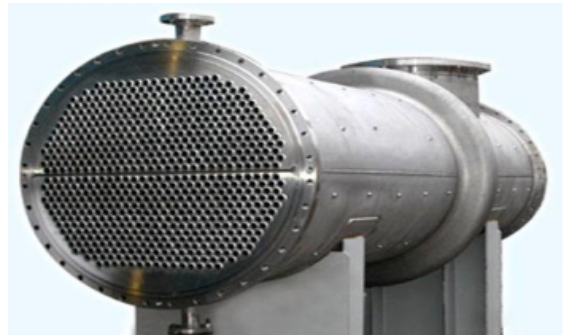As a heat transfer device that transfers part of the heat of the hot fluid between the materials to the cold fluid, the heat exchanger has a wide range of applications in people’s daily life and industries such as petroleum, chemical, power, medicine, atomic energy, and nuclear industry. It can be used as independent equipment, such as heaters, condensers, coolers, etc.; it can also be used as a component of some process equipment, such as heat exchangers in some chemical equipment.
Especially in the chemical industry with large energy consumption, heat exchangers are indispensable equipment in the process of heat exchange and transfer in chemical production, and also occupy a considerable proportion of the entire chemical production equipment.
From the perspective of its function, the heat exchanger is on the one hand to ensure the specific temperature required for the medium in the industrial process, and on the other hand, it is also the main equipment to improve the energy utilization rate. According to its structure, there are mainly plate heat exchangers, floating head heat exchangers, fixed tube plate heat exchangers, and U-shaped tube heat exchangers. In addition to plate heat exchangers, the rest belong to shell and tube heat exchangers.
Shell-and-tube heat exchangers have the advantages of large heat exchange area per unit volume, good heat exchange effect, firm structure, strong adaptability, and mature manufacturing process, and have become the most commonly used typical heat exchanger. Heater.
Connection of heat exchange tubes and tube sheets in shell and tube heat exchangers
In the shell and tube heat exchanger, the heat exchange tube and the tube sheet are the only barriers between the tube side and the shell side of the heat exchanger. The connection structure and connection quality between the heat exchange tube and the tube sheet determine the quality of the heat exchanger. Quality and service life is a crucial part of the heat exchanger manufacturing process.
Most of the damage and failure of heat exchangers occur at the connection between the heat exchange tube and the tube sheet, and the quality of the connection joints also directly affects the safety and reliability of chemical equipment and devices. The connection process between the heat pipe and the tube sheet has become the most critical control link in the heat exchanger manufacturing quality assurance system. At present, in the heat exchanger manufacturing process, the main methods of connecting the heat exchange tube and the tube sheet are weldings, expansion, expansion and welding, and glue and expansion.
1. Welding
When the heat exchange tube and the tube sheet are connected by welding, due to the low processing requirements of the tube sheet, the manufacturing process is simple, the sealing performance is good, and the welding, appearance inspection, and maintenance are very convenient. It is the most widely used connection method for the connection between heat exchange tubes and tube sheets. When using welded connections, there is strength welding to ensure the tightness and pull-off strength of the welded joints, and sealing welding to only ensure the tightness of the connection between the heat exchange tube and the tube sheet. For strength welding, its performance is limited, and it is only suitable for occasions with small vibration and no crevice corrosion.
When welding is used, the distance between the heat exchange tubes should not be too close, otherwise, due to the influence of heat, the quality of the welding seam will not be guaranteed. The length of the heat exchange tube extending out of the tube sheet should meet the specified requirements to ensure its effective bearing capacity. In the welding method, according to the material of the heat exchange tube and the tube sheet, welding can be carried out by electrode arc welding, TIG welding, CO2 welding, and other methods. For heat exchangers with high connection requirements between heat exchange tubes and tube sheets, such as high design pressure, high design temperature, large temperature change, heat exchangers under alternating loads, thin tube sheet heat exchangers, etc., TIG welding should be used.
The conventional welding connection method is prone to crevice corrosion and overheating due to the gap between the tube and the tube sheet hole, and the thermal stress generated at the welded joint may also cause stress corrosion and damage, which will cause the heat exchanger to fail. At present, in the heat exchangers used in the domestic nuclear industry, power industry, and other industries, the connection between the heat exchange tube and the tube sheet has begun to use the inner hole welding technology. This connection method changes the end welding of the heat exchange tube and the tube sheet to The inner hole welding of the tube bundle and adopts the form of full penetration, which eliminates the gap of the end welding and improves the resistance to crevice corrosion and stress corrosion.
It has high anti-vibration fatigue strength, can withstand high temperature and high pressure, and has good mechanical properties of welded joints; internal non-destructive testing of joints can be performed, and the internal quality of welds can be controlled, which improves the reliability of welds. However, the inner hole welding technology is difficult to assemble and requires high welding technology, complex manufacturing and inspection, and relatively high manufacturing cost. With the development of heat exchangers to high temperature, high pressure, and large scale, the requirements for their manufacturing quality are getting higher and higher, and the inner hole welding technology will be more widely used.
2. Expansion
The expansion joint is a traditional method of connecting heat exchange tubes and tube sheets. The tube sheet and the tube are elasto-plastically deformed and tightly fitted by means of a tube expansion device to form a firm connection, so as to achieve the purpose of both sealing and resistance to pull-off. In the manufacturing process of the heat exchanger, an expansion joint is suitable for occasions without severe vibration, excessive temperature change, and serious stress corrosion.
3. Expansion and welding
When the temperature and pressure are high, and under the action of thermal deformation, thermal shock, thermal corrosion, and fluid pressure, the connection between the heat exchange tube and the tube sheet is easily damaged, and it is difficult to ensure the connection strength and tightness by expansion or welding. requirements. At present, the method of expansion welding is widely used. The expansion joint and welding structure can effectively damp the damage of the tube bundle vibration to the weld, can effectively eliminate stress corrosion and crevice corrosion, improve the fatigue resistance of the joint, and thus improve the service life of the heat exchanger.
(1) The lubricating oil used in the welding expansion after expansion will penetrate into the joint gap, and they have a strong sensitivity to welding cracks, pores, etc., so the phenomenon of defects during welding is more serious. It is difficult to remove these oil stains that penetrate into the gap, so the process of first expansion and then welding is adopted, and mechanical expansion is not suitable. Although it is not pressure-resistant, it can eliminate the gap between the tube and the tube hole of the tube sheet, so it can effectively dampen the vibration of the tube bundle to the welding part of the nozzle.
However, the conventional manual or mechanically controlled expansion method cannot achieve uniform expansion requirements, while the liquid bag expansion method in which the expansion pressure is controlled by a computer can easily and uniformly achieve the expansion requirements. During welding, due to the influence of molten metal at high temperatures, the gas in the gap is heated and expands rapidly. These gases with high temperature and high pressure will cause certain damage to the sealing performance of the strong expansion when they leak out.
(2) Welding before expansion For the welding and expansion process, the primary problem is to control the accuracy and coordination of the pipe and the tube sheet hole. When the gap between the tube and the tube hole of the tube sheet is small to a certain value, the expansion process will not damage the quality of the welded joint. However, the ability of the welded joint to withstand shearing force is relatively poor, so during strength welding, if the control does not meet the requirements, it may cause overexpansion failure or damage to the welded joint.
4. Glue joint expansion joint
The process of gluing and expansion can help solve the problems of leakage and leakage that often occur at the connection between the heat exchange tube and the tube sheet in the heat exchanger. It is important to select the glue correctly according to the working conditions of the parts to be glued. . In the process of process implementation, the process parameters should be selected in combination with the structure and size of the heat exchanger, mainly including curing pressure, curing temperature, expansion force, etc., and strictly controlled in the production process. This process is simple, easy to implement, and reliable, has been recognized in the actual use of enterprises, and has promotion value.
In the connection method between the heat exchange tube and the tube sheet of the shell-and-tube heat exchanger, it is difficult to ensure the connection strength and the requirements for sealing by using conventional welding or expansion alone; the expansion and welding method is beneficial to ensure heat exchange The connection strength and tightness between the tube and the tube sheet can improve the service life of the heat exchanger; the method of glued and expanded joint helps to solve the leakage and leakage problems when the heat exchange tube and the tube sheet are connected, and the process is simple Easy to operate and reliable; as a full penetration welding method, the inner hole welding technology has good resistance to crevice corrosion and stress corrosion, vibration fatigue strength, and mechanical properties of welded joints; the internal quality of the weld can be controlled, The reliability of the weld is improved, and it is more suitable for promotion and application in high-end products.

